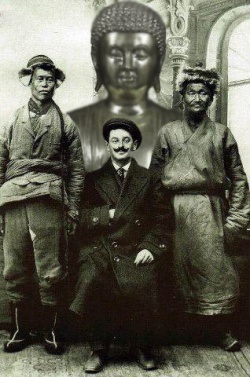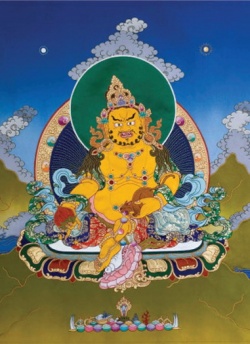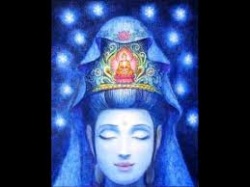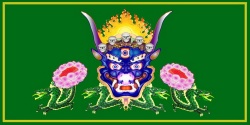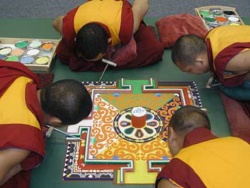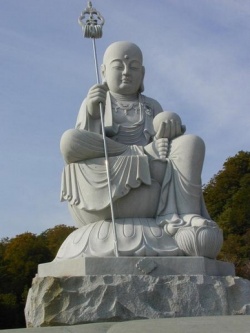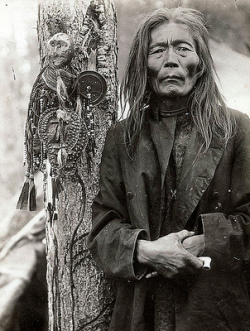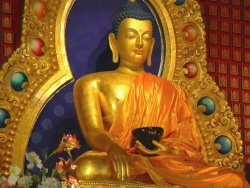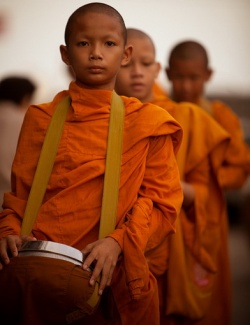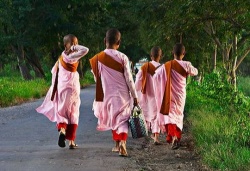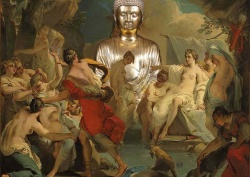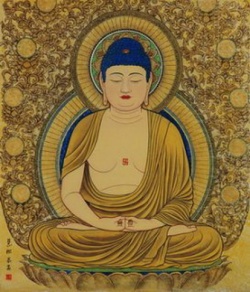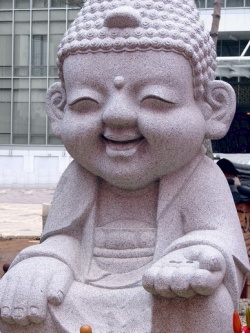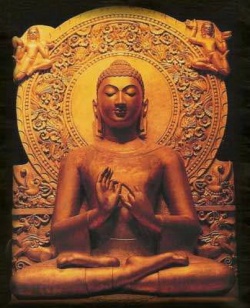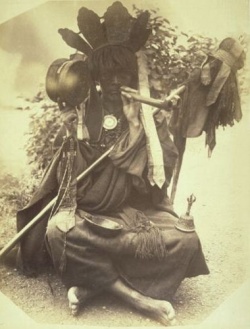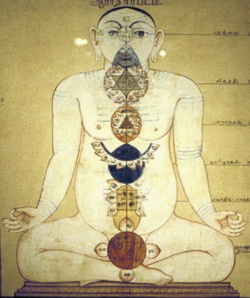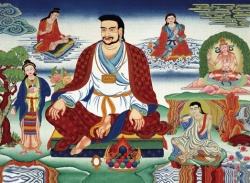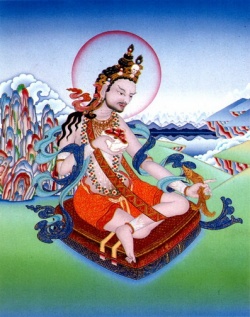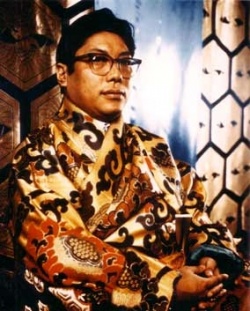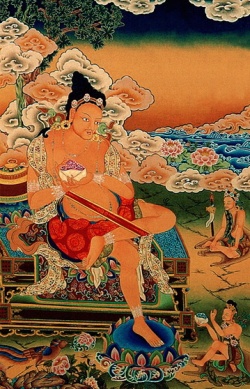Mahamudra
Mahamudra (Skt. Mahāmudrā; Tib. Chakgya Chenpo; Wyl. phyag rgya chen po), or ‘Great Seal’ is the meditation tradition of the Kagyü lineage which passed from Maitripa and Naropa in India to Marpa Lotsawa in Tibet.
Mahamudra (S): Tibetan: Chag gya Chenpo. Great Seal or Symbol.
The highest meditative transmission/teaching in the Tibetan Kagyu school as is "Dzogchen" or Great Perfection in the Nyingma school.
Lineages proceed through Tilopa, Naropa and Marpa, Milarepa and Gampopa.
The Mahamudra Sutra emphasizes dwelling in tranquility and insight, and progressing along the Five Paths (which starts with the beginning of Dharma practice and the accumulation of merit and ends with complete Enlightenment).
Definition
Mudra means that it encompasses all phenomena of samsara, nirvana, and the path.
In other words, they are 'sealed' within it. It is called maha or “great,” because nothing is superior to it.
Subdivisions or Levels of Interpretation
- Mahamudra of the sutra system refers to the attainment of perfect enlightenment through the five paths and ten bhumis.
- Tantric Mahamudra is related to the inner yogas and the practice of dzogrim.
- Essence Mahamudra (Tib. ངོ་བོའི་ཕྱག་རྒྱ་ཆེན་པོ་, Wyl. ngo bo'i phyag rgya chenpo) is closer to Dzogchen and is described in terms of a meditative practice leading to the nature of mind.
Relationship to Dzogchen
Jamgön Kongtrul said that Mahamudra corresponds to the Semdé teachings of Dzogpachenpo.[1]
Footnotes
Further Reading
- Dakpo Tashi Namgyal, Mahamudra, The Moonlight: Quintessence of Mind]] and Meditation, translated by Lobsang P. Lhalungpa, Wisdom Publications, 2nd ed. 2006.
- Jackson, Roger R. and Kapstein, Matthew T. (ed.) Mahāmudrā and the bKa´-brgyud Tradition [PIATS 2006: Proceedings of the Eleventh Seminar of the International Association for Tibetan Studies. Königswinter 2006], 2011
- Kalu Rinpoche, The Union of Mahamudra and Dzogchen, Khyentse Özer, Rigpa, London, 1990.
- Khenchen Thrangu Rinpoche, Crystal Clear: Practical Advice for Mahamudra Meditators, translated by Erik Pema Kunsang, Ragjung Yeshe, 2004.
- Roberts, Peter Alan. Mahamudra and Related Instructions: Core Teachings of the Kagyu Schools
See Also
Source
Mahāmudrā (Sanskrit, Tibetan: Chagchen, Wylie: phyag chen, contraction of Chagya Chenpo, Wylie: phyag rgya chen po) literally means "great seal" or "great symbol."
It "is a multivalent term of great importance in later Indian Buddhism and Tibetan Buddhism" which "also occurs occasionally in Hindu and East Asian Buddhist esotericism."
The name refers to a body of teachings representing the culmination of all the practices of the new translation schools of Tibetan Buddhism, who believe it to be the quintessential message of all of their sacred texts.
The mudra portion denotes that in an adept's experience of reality, each phenomenon appears vividly, and the maha portion refers to the fact that it is beyond concept, imagination, and projection.
History and semantic field
The usage and meaning of the term mahāmudrā evolved over the course of hundreds of years of Indian and Tibetan history, and as a result, the term may refer variously to "a ritual hand-gesture, one of a sequence of 'seals' in Tantric practice,
the nature of reality as emptiness, a meditation procedure focusing on the nature of Mind, an innate blissful gnosis cognizing emptiness nondually, or the supreme attainment of buddhahood at the culmination of the Tantric path."
Etymology in the tantras
It has been speculated that the first use of the term was in the c. 7th century Mañjuśrīmūlakalpa, in which it refers to a hand gesture.
The term is mentioned with increasing frequency as Buddhist tantra developed further, particularly in the Yogatantras, where it appears in Tattvasaṁgraha and the Vajraśekhara tantra.
Here it also denotes a hand gesture, now linked to three other hand mudrās—the action (karma), pledge (samaya), and dharma mudrās—but also involves "mantra recitations and visualizations that symbolize and help to effect one’s complete identification with a deity’s divine form or awakening Mind (bodhicitta)."
In Mahāyoga tantras such as the Guhyasamāja tantra, it "has multiple meanings, including a contemplation-recitation conducive to the adamantine body, speech, and Mind of the tathāgatas;
and the object-—emptiness-—through realization of which 'all is accomplished,'" and it is also used as a synonym for awakened Mind, which is said to be "primordially unborn, empty,
unarisen, nonexistent, devoid of self, naturally luminous, and immaculate like the sky."
In the yoginī or Anuttarayoga tantras, mahāmudrā "emerges as a major Buddhist concept."> As scholar Roger Jackson explains,
- Though still connected there to creation-stage maṇḍala practice, it is more often related to completion-stage meditations involving the manipulation of mental and physical forces in the subtle body so as to produce a divine form and a luminous, blissful, nonconceptual gnosis.
In the completion-stage discussions in such Tantric systems as the Hevajra, Cakrasaṁvara, and Kālacakra, mahāmudrā has three especially important meanings.
First, it may refer to a practitioner’s female consort in sexual yoga practices.
Second, as before, it is one of a sequence of mudrās corresponding to various Buddhist concepts, experiences, and path-stages.
Here, though, it usually is the culmination of the series, a direct realization of the nature of Mind and reality that transcends and perfects other, more conventional seals, including those involving actual or visualized sexual yoga.
Third, Mahāmudrā by itself connotes the ultimate truth, realization, or achievement of yoginī Tantra practice:
the great seal that marks all phenomena and experiences; a synonym for suchness, sameness, emptiness, space, and the goddess Nairātmyā (no-self);
unchanging bliss beyond object and subject, shape, thought, or expression; and the ultimate gnostic attainment, mahāmudrā-siddhī.
Thubten Yeshe explains: "Mahāmudrā means absolute seal, totality, unchangeability.
Sealing something implies that you cannot destroy it.
Mahāmudrā was not created or invented by anybody; therefore it cannot be destroyed. It is absolute reality".
Aryadeva summarises: "The discussion of how to attain mahāmudrā entails methods for meditating on Mind itself as something having voidness as its nature".
Lineages
Mahāmudrā is most well known as a teaching within the Kagyu (w. Bka´ brgyud) lineages of Tibetan Buddhism.
However the Tibetan Buddhist Gelug and Sakya schools also practice mahāmudrā, as does Shingon Buddhism , the other major sub-school of the Vajrayana.
The Nyingma and Bön traditions practice Dzogchen, a cognate but distinct method of direct introduction to the empty nature of Mind.
Nyingma students may also receive supplemental training in mahāmudrā, and the Palyul Nyingma lineage preserves a lineage of the "Union of Mahāmudrā and Ati Yoga" originated by Karma Chagme.
All of the various Tibetan mahāmudrā lineages originated with the tantric Mahasiddhas of the Pala Empire India in the 8th to 12th Centuries.
The 'Profound Action' lineage originated with Maitreya and Asanga and was introduced to Tibet by Marpa and Atisha.
Marpa introduced the lineage to the Kagyu school and Atisha to the Kadam school, which later produced the Gelug school.
Gampopa later received both the Kagyu and Kadam transmissions of the lineage and passed them through to the present day Kagyu.
The 'Profound View' lineage of mahāmudrā, which originated with Nagarjuna, also was introduced to Tibet by Atisha.
Marpa introduced to Tibet the 'Profound Blessing Meditation Experience' lineage that is believed to have originated with the primordial Buddha Vajradhara and was passed to Tilopa and Naropa.
Marpa also introduced a mahāmudrā lineage that traced back through Saraha and Maitripa.
===Kagyu tradition===
The Kagyu lineage divides the mahāmudrā teachings into three types,
"sutra mahāmudrā,"
"tantra mahāmudrā," and
"essence mahāmudrā,"
in a formulation that appears to originate with Jamgon Kongtrul.
Sutra mahāmudrā, as the name suggests, draws its philosophical view and meditation techniques from the sutrayana tradition.
Tantric mahāmudrā employs such tantric techniques as tummo, dream yoga, and clear light yoga, three of the six yogas of Naropa.
Essence mahāmudrā is based on the direct instruction of a qualified lama, known as pointing-out instruction.
There have been many prominent practitioners and scholars of mahāmudrā in the Kagyu tradition.
The Third Karmapa wrote;
'Aspiration Prayer of Mahāmudrā'.
The Ninth Karmapa wrote
'Pointing Out the Dharmakaya' (Tibetan: Chos sku mdzub tshugs);
'An Ocean of the Definite Meaning' (Tibetan:Nges don rGya mtsho) and
'Eliminating the Darkness of Ignorance'.
Tsele Natsok Rangdrol wrote the
'Lamp of Mahāmudrā' and
Dakpo Tashi Namgyal wrote
'Clarifying the Natural State' and
'Moonlight of Mahāmudrā'.
The particular Kagyu propensity to blend sutric and tantric traditions of mahāmudrā was a point of controversy in Tibet, with Sakya Pandita one of the most prominent critics thereof.
As scholar Klaus-Dieter Mathes notes
- Certain aspects of the Bka´ brgyud teachings on mahāmudrā, such as the possibility of a sudden liberating realization or the possibility that a beginner may attain mahāmudrā even without Tantric initiation, became a highly controversial issue in the 13th century.
For Sakya Paṇḍita (1182–1251), such teachings represented a new development stemming from a Sino-Tibetan influence on Sgam po pa Bsod nams rin chen (1079–1153).
Later Bka´ brgyud pas defended their not specifically Tantric or sūtra mahāmudrā tradition by adducing Indian sources such as the Tattvadaśakaṭīkā or the Tattvāvatāra.
These belong to a genre of literature which the Seventh Karmapa Chos grags rgya mtsho (1454–1506) called “Indian mahāmudrā-Works” (phyag chen rgya gzhung). . . .
Dr. Mathes investigated the practice described in these mahāmudrā works and found that it is not necessarily Tantric.
In Saraha´s dohās it is simply the realization of Mind´s co-emergent nature with the help of a genuine guru.
Maitrīpa (ca. 1007– ca. 1085) uses the term mahāmudrā for precisely such an approach, thus employing an originally Tantric term for something that is not a specifically Tantric practice.
It is thus legitimate for later Bka´ brgyud pas to speak of Saraha´s mahāmudrā tradition as being originally independent of the Sūtras and the Tantras.
For Maitrīpa, the direct realization of emptiness (or the co-emergent) is the bridging link between the Sūtras and the Tantras, and it is thanks to this bridge that mahāmudrā can be linked to the Sūtras and the Tantras.
In the Sūtras it takes the form of the practice of non-abiding and becoming mentally disengaged, while in the Tantras it occupies a special position among the four mudrās.
The First Panchen Lama identified a number of mahāmudrā lineages, according to their main practices for achieving mahāmudrā:
- From the point of view of individually ascribed names, there are numerous traditions, such as those of the simultaneously arising as merged, the amulet box, possessing five, the six spheres of equal taste, the four syllables, the pacifier, the object to be cut off, dzogchen, the discursive madhyamaka view, and so on.
In his teachings on the First Panchen Lama's root text and auto-commentary the Dalai Lama XIV delineated the Kagyu practice lineages as follows:
- The Karma Kagyu "Simultaneously Arising as Merged" tradition - This is the tradition introduced by Gampopa with a main practice of the Six Yogas of Naropa.
- The Shangpa Kagyu "Amulet Box" tradition - This tradition came from Khyungpo Naljor and its main practice is the Six Yogas of Niguma.
- The Drigung Kagyu "Possessing Five" tradition - Jigten Gonpo founded the school and mahāmudrā lineage whose main practice is devotion via Guru Yoga and purification and merit collection practices.
- The Drukpa Kagyu "Six Spheres of Equal Taste" tradition - Tsangpa Gyare founded this tradition which encompasses a range of practices, including the Six Yogas of Naropa.
- The Dagpo Kagyu "Four Syllables" tradition - This is the tradition that derives from Matripa.
The four syllables are a-ma-na-si which comprise the Sanskrit word meaning 'not to take to mind' and passed through the Dagpo Kagyu branches, i.e. any that descend from the teachings of Tilopa rather than those of Niguma, which in practice means all but the Shangpa Kagyu.
Gelug tradition
The First and Second Panchen Lamas wrote important discourses about mahāmudrā from the Gelug perspective.
The main text of the First Panchen Lama is 'A root text for the precious Gelug/Kagyu tradition of mahāmudrā: The Main Road of the Triumphant Ones' (Tibetan:dGe ldan bka' brgyud rin po che'i phyag chen rtsa ba rgyal ba'i gzhung lam zhes bya ba) .
Sakya mahāmudrā
According to Alexander Berzin:
The Kagyu and Gelug/Kagyu traditions have both sutra and anuttarayoga tantra levels of the practice, while Sakya only an anuttarayoga one.
In other words, Sakya mahāmudrā focuses only on the nature of clear light mental activity, while the other two traditions include focus on the nature of the other levels of mental activity as well.
Meditation
The advice and guidance of a qualified teacher is considered to be very important in learning and practicing mahāmudrā meditation. Most often mahāmudrā (particularly essence mahāmudrā) is preceded by pointing-out instruction.
Before the 1955 invasion of Tibet, many of the texts and information that are now available would have been esoteric and restricted.
The Dalai Lama has been influential in making public some of these formerly esoteric Tibetan teachings, while still some remain entirely esoteric, available to a student only through a private guru-student relationship.
Some parts of the transmission are done verbally and through empowerments and "reading transmissions."
A student typically goes through various tantric practices before undertaking the "formless" practices described below;
the latter are classified as part of "essence mahāmudrā."
Ngondro is the preliminary practice common to both mahāmudrā and dzogchen traditions.
According to one scholar, most people have difficulty beginning directly with formless practices and lose enthusiasm doing so, so the tantric practices work as a complement to the formless ones.
Approaches
As in most Buddhist schools of meditatione basic meditative practice of mahāmudrā is divided into two approaches: śamatha ("tranquility","calm abiding") and vipaśyanā ("special insight").
This division is contained in the instructions given by Wangchuk Dorje, the ninth Karmapa, in a series of texts he composed; these epitomize teachings given on mahāmudrā practice.
Śamatha
Mahāmudrā śamatha contains instructions on ways to sit with proper posture.
The mahāmudrā shamatha teachings also include instructions on how to work with a mind that is beset with various impediments to focusing, such as raising the gaze when one feels dull or sleepy, and lowering it again when one feels overly excited.
Two types of mahāmudrā śamatha are generally taught: śamatha with support and śamatha without support.
With support
Mahāmudrā śamatha with support involves the use of an object of attention to which the meditator continually returns his or her attention.
One of the main techniques involved in Mahāmudrā śamatha with support is mindfulness of breathing (S. ānāpānasmṛti).
Mindfulness of breathing practice is considered to be quite profound means of calming the mind to prepare it for the stages that follow.
For the Kagyupa, in the context of mahāmudrā, mindfulness of breathing is thought to be the ideal way for the meditator to transition into taking the mind itself as the object of meditation and generating vipaśyanā on that basis.
The prominent contemporary Kagyu/Nyingma master Chogyam Trungpa, expressing the Kagyu Mahāmudrā view, wrote, "your breathing is the closest you can come to a picture of your mind.
It is the portrait of your mind in some sense...
The traditional recommendation in the lineage of meditators that developed in the Kagyu-Nyingma tradition is based on the idea of mixing mind and breath."
Vipaśyanā
The detailed instructions for the insight practices are what make mahāmudrā (and Dzogchen) unique in Tibetan Buddhism.
In Mahāmudrā vipaśyanā, Wangchuck Dorje gives ten separate contemplations that are used to disclose the essential mind within;
five practices of "looking at" and five of "pointing out" the nature of mind.
They all presume some level of stillness cultivated by mahāmudrā shamatha.
In retreat, each contemplation would typically be assigned specific time periods.
The five practices for "looking at" the nature of the mind are as follows:
- Looking at the settled mind. One repeatedly looks at the mind's still state, possibly posing questions to arouse awareness, such as "what is its nature? It is perfectly still?"
- Looking at the moving or thinking mind. One tries to closely examine the arising, existence, and ceasing of thoughts, possibly posing oneself questions so as to better understand this process, such as "how does it arise? What is its nature?"
- Looking at the mind reflecting appearances. One looks at the way in which phenomena of the external senses occur in experience. Usually, a visual object is taken as the subject. One repeatedly looks at the object, trying to see just how that appearance arises in the mind, and understand the nature of this process. One possibly asks questions such as "what is their nature? How do they arise, dwell, and disappear? Is their initial appearance different from how they eventually understood?"
- Looking at the mind in relation to the body. One investigates questions such as "what is the mind? What is the body? Is the body our sensations? What is the relation of our sensations to our mental image of our body?"
- Looking at the settled and moving minds together. When the mind is still, one looks at that, and when the mind is in motion, one looks at that. One investigates whether these two stages are the same or different, asking questions such as "if they are the same, what is the commonality? If different, what is the difference?"
The practices for "pointing out the nature of mind" build on these. One now looks again at each of the five, but this time repeatedly asks oneself "What is it?"
In these practices, one attempts to recognize and realize the exact nature of, respectively:
- The settled mind,
- The moving or thinking mind,
- The mind reflecting appearances,
- The relation of mind and body,
- The settled and thinking mind together.
The above practices do not have specific "answers"; they serve to provoke one to scrutinize experience more and more closely over time, seeking to understand what is really there.
Four yogas
Mahāmudrā is sometimes divided into four distinct phases known as the four yogas of mahāmudrā (S. catvāri mahāmudrā yoga, Wylie: phyag rgya chen po'i rnal 'byor bzhi). They are as follows:
- one-pointedness (S. ekāgra, T. rtse gcig)
- simplicity (S. niṣprapāncha, T. spros bral) "free from complexity" or "not elaborate."
- non-meditation (S. abhāvanā, sgom med)
The state of not holding to either an object of meditation nor to a meditator. Nothing further needs to be 'meditated upon' or 'cultivated at this stage.
These stages parallel the Semde#Four_Yogas_of_Semde|four yogas of Dzogchen semde)].
The four yogas of mahāmudrā have been correlated with the Mahāyāna five paths (S. pañcamārga) as follows:
According to Tsele Natsok Rangdrol (Lamp of Mahāmudrā):
- One-pointedness: path of application
- Simplicity: paths of seeing and most of the path of meditation (bhūmis one through six)
- One taste: last part of the path of meditation, most of the path of no-more-learning (bhūmis seven through nine)
- Nonmeditation: last part of the path of no-more learning (tenth bhūmi) and buddhahood (bhūmis eleven through thirteen)
According to Dakpo Tashi Namgyal (Moonlight of Mahāmudrā):
- Outer and inner preliminary practices and one-pointedness: path of accumulation
- Simplicity: path of application
- One taste: paths of meditation & no-more-learning
- Nonmeditation: path of no more learning & buddhahood
According to Je Gyare as reported by Dakpo Tashi Namgyal (Moonlight of Mahāmudrā):
- One-pointedness: paths of accummulation and application
- Simplicity: path of seeing (first bhūmi)
- One taste: paths of meditation and part of the path no-more-learning (bhūmis two through eight)
- Nonmeditation: rest of path of no-more-learning, buddhahood (bhūmis nine through thirteen)
According to Drelpa Dönsal as reported by Dakpo Tashi Namgyal (Moonlight of Mahāmudrā):
- One-pointedness: paths of accummulation and application
- Simplicity: path of seeing (first bhūmi)
- One taste: paths of meditation and no-more-learning (bhūmis two through ten)
- Nonmeditation: buddhahood (bhūmis eleven through thirteen)
Six Words of Advice
Tilopa was a Bengali mahasiddha who developed the mahāmudrā method around 1,000 C.E. Tilopa gave Naropa, his successor, a teaching on mahāmudrā meditation called the Six Words of Advice.
In the following chart a translation is given of the Tilopa's Six Words of Advice.
| First short, literal translation | Later long, explanatory translation | Tibetan (Wylie transliteration) | |
|---|---|---|---|
| 1 | Don’t recall | Let go of what has passed | mi mno |
| 2 | Don’t imagine | Let go of what may come | mi bsam |
| 3 | Don’t think | Let go of what is happening now | mi shes |
| 4 | Don’t examine | Don’t try to figure anything out | mi dpyod |
| 5 | Don’t control | Don’t try to make anything happen | mi sgom |
| 6 | Rest | Relax, right now, and rest | rang sar bzhag |
Source
Wikipedia:Mahamudra
[[Category:
